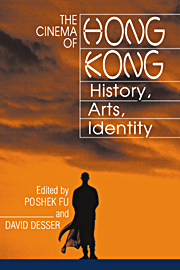Book contents
- Frontmatter
- Contents
- List of Contributors
- Acknowledgments
- Introduction
- Chronology of Hong Kong Cinema
- PART I HISTORY
- PART II ARTS
- PART III IDENTITY
- 9 Between Nationalism and Colonialism: Mainland Émigrés, Marginal Culture, and Hong Kong Cinema 1937–1941
- 10 Urban Cinema and the Cultural Identity of Hong Kong
- 11 Rewriting History: Hong Kong Nostalgia Cinema and Its Social Practice
- 12 Filming Diaspora and Identity: Hong Kong and 1997
- 13 Buying American, Consuming Hong Kong: Cultural Commerce, Fantasies of Identity, and the Cinema
- 14 Hong Kong Electric Shadows: A Selected Bibliography of Studies in English
- Index
10 - Urban Cinema and the Cultural Identity of Hong Kong
Published online by Cambridge University Press: 05 June 2012
- Frontmatter
- Contents
- List of Contributors
- Acknowledgments
- Introduction
- Chronology of Hong Kong Cinema
- PART I HISTORY
- PART II ARTS
- PART III IDENTITY
- 9 Between Nationalism and Colonialism: Mainland Émigrés, Marginal Culture, and Hong Kong Cinema 1937–1941
- 10 Urban Cinema and the Cultural Identity of Hong Kong
- 11 Rewriting History: Hong Kong Nostalgia Cinema and Its Social Practice
- 12 Filming Diaspora and Identity: Hong Kong and 1997
- 13 Buying American, Consuming Hong Kong: Cultural Commerce, Fantasies of Identity, and the Cinema
- 14 Hong Kong Electric Shadows: A Selected Bibliography of Studies in English
- Index
Summary
In discussing Hong Kong culture, critics are often in discord in their various attempts to define the cultural identity of Hong Kong. Whereas some insist that Hong Kong has developed a unique form of culture that is different from Chinese culture, others deny the existence of a separate identity and merely recognize it as one part of Chinese culture not unlike other regional cultures, all sharing the overall national characteristics. Among those trying to draw the dividing line, some point to 1949, the year the People's Republic of China was established and a generation of exiles began to immigrate from China to settle in Hong Kong. This was regarded as the beginning of the crucial break between a socialist China and a capitalist colonial city. There are also others who see a more important break emerging in the years between 1966 and 1976 during the tumultuous Cultural Revolution in China, especially when the extreme leftists in Hong Kong, under the influence of those in China, turned social unrest and demonstrations into organized violent actions.
This chapter tries to approach the complexities of Hong Kong's cultural identity through a series of films. It attempts to establish that one main characteristic that distinguishes Hong Kong from mainland China is shown in its formation of urban culture since 1949, especially during the 1960s, and aims to scrutinize films from the 1950s to the 1990s, which focus on the city of Hong Kong so as to examine how cultural workers define and rethink their cultural identity through the construction of various narratives about and images of their city.
- Type
- Chapter
- Information
- The Cinema of Hong KongHistory, Arts, Identity, pp. 227 - 251Publisher: Cambridge University PressPrint publication year: 2000
- 4
- Cited by

